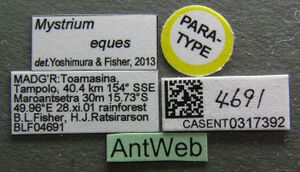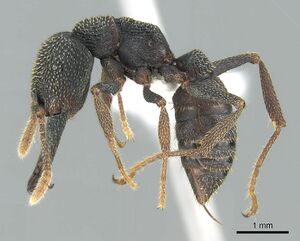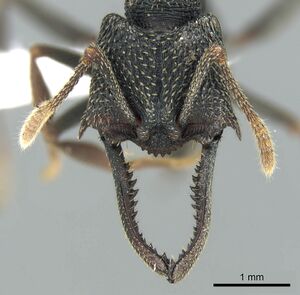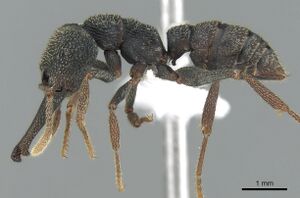Mystrium eques
| Mystrium eques | |
|---|---|

| |
| Scientific classification | |
| Kingdom: | Animalia |
| Phylum: | Arthropoda |
| Class: | Insecta |
| Order: | Hymenoptera |
| Family: | Formicidae |
| Subfamily: | Amblyoponinae |
| Tribe: | Amblyoponini |
| Genus: | Mystrium |
| Species group: | voeltzkowi |
| Species: | M. eques |
| Binomial name | |
| Mystrium eques Yoshimura & Fisher, 2014 | |
Nothing is known about the biology of Mystrium eques.
Identification
Yoshimura and Fisher (2014) - The worker of Mystrium eques is easily distinguished from those of other Mystrium species by a combination of the following characters: strong and deep longitudinal sculpture on the dorsal and lateral surface of pronotum; anteromedial portion of the clypeus strongly convex anteriorly; and sharper angle between the posterior and dorsal faces of the vertex on the median line. The queen of M. eques is differentiated from other Mystrium queens by having vestigial wings reduced to small appendages with undeveloped wing sclerites (ergatoid), posterior face of the vertex forming approximately a right angle with its dorsal face on the median line, and a strongly convex anterior clypeal margin.
The worker of M. eques is similar to that of Mystrium oberthueri, however, the strongly convex anterior clypeal margin separates M. eques from M. oberthueri, in which the anterior margin of the clypeus is straight.
Keys including this Species
Distribution
Latitudinal Distribution Pattern
Latitudinal Range: -15.28833° to -23.01583°.
| North Temperate |
North Subtropical |
Tropical | South Subtropical |
South Temperate |
- Source: AntMaps
Distribution based on Regional Taxon Lists
Malagasy Region: Madagascar (type locality).
Distribution based on AntMaps
Distribution based on AntWeb specimens
Check data from AntWeb
Countries Occupied
| Number of countries occupied by this species based on AntWiki Regional Taxon Lists. In general, fewer countries occupied indicates a narrower range, while more countries indicates a more widespread species. |

|
Estimated Abundance
| Relative abundance based on number of AntMaps records per species (this species within the purple bar). Fewer records (to the left) indicates a less abundant/encountered species while more records (to the right) indicates more abundant/encountered species. |

|
Biology
|
Castes
Worker
Images from AntWeb
   
| |
| Paratype of Mystrium eques. Queen (ergatoid). Specimen code casent0317391. Photographer Estella Ortega, uploaded by California Academy of Sciences. | Owned by MCZ, Cambridge, MA, USA. |
   
| |
| Paratype of Mystrium eques. Queen (ergatoid). Specimen code casent0317392. Photographer Estella Ortega, uploaded by California Academy of Sciences. | Owned by NHMB, Basel, Switzerland. |
   
| |
| Paratype of Mystrium eques. Worker. Specimen code casent0317393. Photographer Estella Ortega, uploaded by California Academy of Sciences. | Owned by CAS, San Francisco, CA, USA. |
   
| |
| Paratype of Mystrium eques. Worker. Specimen code casent0317394. Photographer Estella Ortega, uploaded by California Academy of Sciences. | Owned by CAS, San Francisco, CA, USA. |
   
| |
| Paratype of Mystrium eques. Worker. Specimen code casent0317395. Photographer Estella Ortega, uploaded by California Academy of Sciences. | Owned by CAS, San Francisco, CA, USA. |
   
| |
| Paratype of Mystrium eques. Worker. Specimen code casent0317396. Photographer Estella Ortega, uploaded by California Academy of Sciences. | Owned by MSNG, Genoa, Italy. |
   
| |
| Paratype of Mystrium eques. Worker. Specimen code casent0317397. Photographer Estella Ortega, uploaded by California Academy of Sciences. | Owned by MHNG, Geneva, Switzerland. |
   
| |
| Paratype of Mystrium eques. Queen (ergatoid). Specimen code casent0317398. Photographer Estella Ortega, uploaded by California Academy of Sciences. | Owned by NHMUK, London, UK. |
   
| |
| Paratype of Mystrium eques. Queen (ergatoid). Specimen code casent0418311. Photographer Estella Ortega, uploaded by California Academy of Sciences. | Owned by CAS, San Francisco, CA, USA. |
   
| |
| Paratype of Mystrium eques. Worker. Specimen code casent0418312. Photographer Estella Ortega, uploaded by California Academy of Sciences. | Owned by MNHN, Paris, France. |
   
| |
| Paratype of Mystrium eques. Worker. Specimen code casent0418313. Photographer Estella Ortega, uploaded by California Academy of Sciences. | Owned by CAS, San Francisco, CA, USA. |
   
| |
| Holotype of Mystrium eques. Worker. Specimen code casent0418314. Photographer Estella Ortega, uploaded by California Academy of Sciences. | Owned by CAS, San Francisco, CA, USA. |
   
| |
| Paratype of Mystrium eques. Worker. Specimen code casent0418316. Photographer Estella Ortega, uploaded by California Academy of Sciences. | Owned by NHMB, Basel, Switzerland. |
   
| |
| Paratype of Mystrium eques. Queen (ergatoid). Specimen code casent0418317. Photographer Estella Ortega, uploaded by California Academy of Sciences. | Owned by MHNG, Geneva, Switzerland. |
   
| |
| Paratype of Mystrium eques. Worker. Specimen code casent0418318. Photographer Estella Ortega, uploaded by California Academy of Sciences. | Owned by ZMHB, Berlin, Germany. |

| |
| Specimen code casent0317443. . | |
Queen
Images from AntWeb
   
| |
| Paratype of Mystrium eques. Queen (ergatoid). Specimen code casent0418315. Photographer Estella Ortega, uploaded by California Academy of Sciences. | Owned by NHMUK, London, UK. |
Nomenclature
The following information is derived from Barry Bolton's Online Catalogue of the Ants of the World.
- eques. Mystrium eques Yoshimura & Fisher, 2014: 69, figs. 18B,D,F, 21A, 22A, 50A, 51A, 52A, 53A, 54A, 55A, 56A (w.ergatoid q.m.) MADAGASCAR.
- Type-material: holotype worker, 13 paratype workers, 5 paratype ergatoid queens.
- Type-locality: holotype Madagascar: Toamasina, Tampolo, Masoala Peninsula, 40.4 km. 154° SSE Maroansetra (-15.73°, 49.96°), 30 m., 28.xi.-3.xii.2001, BLF04691, CASENT0418314 (B.L. Fisher & H.J. Ratsirarson); paratypes with same data but CASENT0317390-CASENT0317399, CASENT0317443, CASENT0418311-CASENT0418318.
- Type-depositories: CASC (holotype); BMNH, CASC, MCZC, MHNG, MNHN, MNHU, MSNG, NHMB (paratypes).
- Distribution: Madagascar.
Unless otherwise noted the text for the remainder of this section is reported from the publication that includes the original description.
Description
Worker
Measurements: holotype. HL 1.78, HW 1.65, SL 1.23, ML 1.87, HD 1.08, WL 2.01, PnW 0.94, PpW 0.83, PtW 0.85, PtL 0.57, CI 92.6, SI 74.4, MI 113.8, PpI 88.6, PtI 150.4.
HL 1.72–2.11, HW 1.59–2, SL 1.26–1.42, ML 1.81–2.18, HD 1.08–1.33, WL 2.07–2.34, PnW 0.92–1.1, PpW 0.83–1.02, PtW 0.83–1.03, PtL 0.54–0.67, CI 91.4–97.3, SI 70.4–78.9, MI 107.4–114.2, PpI 84.7–92.7, PtI 149.5–161.2 (10 specimens measured).
Posterolateral corner of head strongly to moderately expanding posteriorly. Posterior face of vertex forming almost a right angle with dorsal face on median line of head, so that declivity of vertex on lateral part as steep as that on median part. Whole region of vertex finely striated. Eye relatively smaller than that of M. oberthueri. Anterior margin of clypeus strongly convex with long conical setae. Genal tooth of head relatively long, as long as lateral lobe of clypeus. Masticatory margin of mandible almost invisible in full-face view. Width of dorsal surface of mandible on distal portion slightly wider than that on mandibular shaft. Second maxillary palpomere longer than third. First flagellomere (third antennal segment) as long as pedicel (second antennal segment). Strong, deep and thick longitudinal striae regularly impressed on whole central part of pronotal dorsum. Strong, deep, and thick longitudinal striae impressed on lateral surface of pronotum. Mesonotum differentiated from propodeum in dorsal view, length slightly shorter than that of propodeum. Metanotal groove shallowly and gently impressed, and mesonotum higher than pronotum in lateral view. Metapleural gland bulla moderately developed, and propodeal declivity in lateral view almost straight. Petiole widened on posterior 1/4 and gently narrowed anteriorly in dorsal view, anterior margin straight to gently rounded and sometimes edged by thin striae.
Body color blackish brown. Appendages brighter, and four distal segments of antennal club yellowish.
Queen
Ergatoid Measurements: HL 1.48–1.62, HW 1.41–1.57, SL 1.10–1.25, ML 1.38–1.56, HD 0.99–1.09, WL 1.95–2.10, PnW 0.85–0.95, PpW 0.83–0.94, PtW 0.87–0.97, PtL 0.52–0.56, CI 94.0–97.2, SI 77.7–83.9, MI 93.2– 107.0, PpI 93.8–101.6, PtI 160.5–172.6 (7 specimens measured).
Wings vestigial and forming small but distinct appendages. Wing sclerites undeveloped. Posterolateral corner of head strongly expanding posteriorly, expansion relatively weaker than that of workers. Posterior face of vertex forming almost a right angle with dorsal face on median line of head, so that declivity of vertex on lateral part as steep as on median part. Ventral half of vertex sculptured. Eye small but distinct. Ocelli absent. Anterior margin of clypeus distinctly convex with long to short conical setae. Anterolateral portion of head with short spine. Masticatory margin of mandible almost invisible in full-face view. Dorsal surface of mandible on distal portion slightly wider than that on mandibular shaft. Spatulate or narrow spoon-shaped seta present on basal side of each basal denticle on masticatory margin of mandible. First flagellar segment on antenna about 1.0–1.2× length of pedicel. Setae on pronotum distinctly spatulate, widened distally with sharp or blunt apex. Metapleural gland bulla moderately developed, not expanding to dorsum of propodeal spiracle, so that propodeal declivity in lateral view weakly convex and rounded posteriorly on its ventral 1/3. Petiole relatively long in dorsal view, about 1.0–0.8× length of abdominal segment III.
Body color blackish to reddish brown.
Type Material
Holotype. Worker: CASENT0418314, BLF04691, MADAGASCAR, Toamasina, Tampolo, Masoala Peninsula, 40.4 km 154° SSE Maroantsetra (-15.73°, 49.96°), 30 m alt., 28.xi.–3.xii.2001, B.L.Fisher & H.J.Ratsirarson leg. California Academy of Sciences]. Paratypes. 13 workers: CASENT0317390 CASC, CASENT0317393 CASC, CASENT0317394 CASC, CASENT0317395 CASC, CASENT0317396 MSNG, CASENT0317397 Musee d'Histoire Naturelle Genève, CASENT0317398 The Natural History Museum, CASENT0317399 Museum of Comparative Zoology, CASENT0317443 CASC, CASENT0418312 MNHN, CASENT0418313 CASC, CASENT0418316 Naturhistorisches Museum, Basel, CASENT0418318 Berlin Museum für Naturkunde der Humboldt-Universität; 5 ergatoid queens: CASENT0418311 CASC, CASENT0418315 BMNH, CASENT0418317 MHNG, CASENT0317391 MCZC, CASENT0317392 NHMB, with same data as holotype.
Etymology
This species name is the Latin word eques, inspired by the distinctly developed clypeus (shield) on the new species. The species epithet is a noun and invariant.
References
References based on Global Ant Biodiversity Informatics
- Yoshimura M., and B. L. Fisher. 2014. A revision of the ant genus Mystrium in the Malagasy region with description of six new species and remarks on Amblyopone and Stigmatomma (Hymenoptera, Formicidae, Amblyoponinae). ZooKeys 394: 1-99.


